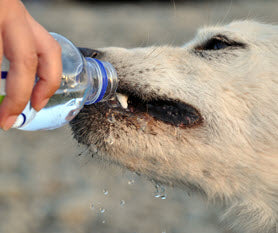Warmer weather beckons us to spend more time outside with our dogs. Everybody benefits from the additional activity and bonding time together. But the higher outdoor temperatures increase the chance of dehydration in your dog, which is a serious health issue. Be sure to provide enough water during outdoor activity, and know the signs of dehydration so you can act quickly if necessary.
WHAT CAUSES DEHYDRATION
Sounds simple enough … they aren’t getting enough water. But it usually involves both a loss of water and electrolytes, which are minerals such as sodium, chloride and potassium. Lots of chasing and running without having any water provided is a common reason for dehydration. But it could also be caused by illness, injury or fever.
When their body doesn’t have enough water, fluids shift out of the cells to compensate, leaving the cells depleted of the needed water. The severity of the dehydration is based on the degree to which the cells are left depleted.
WHAT TO WATCH FOR
Signs of dehydration include loss of skin elasticity, lethargy, depression, sunken eyes, dry gums and increased heart rate. There is a common, but somewhat inaccurate, way to check your dog’s skin elasticity. Pinch the skin on your dog’s back, pull it up and release it, watching to see how quickly it returns to the normal position. In a dehydrated dog, it is slow to return to normal.
If you suspect your dog is dehydrated, a trip to the vet is in order. The professionals will be able to run tests to confirm your dog is dehydrated, determine the severity of the dehydration and set up a treatment plan.
Your veterinarian will likely run a blood test to determine packed cell volume and total blood protein, factors that will reveal if dehydration is present. He may also order a urine test to measure the concentration of the urine, a sign of dehydration, and if the kidneys are affected.
TREATMENT FOR DEHYDRATION
There is really no way to treat your dog for dehydration at home. When your dog is ill and dehydrated, they often cannot drink enough water to correct the dehydration.
In these cases, your vet might suggest administering intravenous fluids. This method supplies fluids to their body slowly, allowing the body to compensate and slowly replenish the depleted cells.
Some animals can be treated with injections of fluid right under the skin. If your veterinarian recommends this, and if you are comfortable with doing it yourself, their staff can show you how to give the fluid injections at home.
The best way to prevent dehydration is to make sure your dog eats and drinks normally. If your dog seems ill, an early trip to the vet will speed up the diagnosis, treatment and recovery from dehydration.
This blog is brought to you by Under the Weather®, provider of bland diet products for dogs. When your dog experiences occasional or temporary vomiting or diarrhea, be ready with our freeze-dried bland diets. No more cooking – just add boiling water! Made with 100% lean meats, vegetables and grains, all raised or grown in the U.S.A. Gluten free, no meat by-products, no artificial anything. Even picky pups love this product!
View Our Products
Visit Our Blog Library




